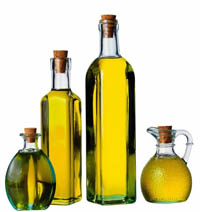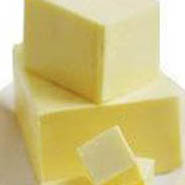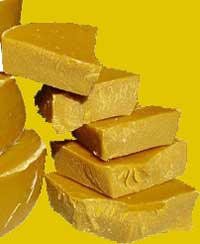 Vegetable fats are liquid substances, the exception is of coconut oil.
Vegetable fats are liquid substances, the exception is of coconut oil.There is a significant difference between vegetable and animal fats. So, the liquid fat consists of an unsaturated acids, and the solid fatsconsists of saturated. For example, liquid fat - contains oleic acid, C17H33COOH or linoleic acid (C17H31COOH. Solid fat contains, for example, palmitic acid (C15H31COOH or stearic acid (C17H35COOH.
So, fats and oils belong to the class of conplex esters. Fats with proteins and carbohydrates constitute a group of organic compounds that have exceptional physiological importance: they are an main part of food!
Fats are important in technical terms: they are the source of glycerin, higher carboxylic acids and soaps. Some vegetable fats and oils are used for manufacture of varnish, linoleum, oil paint and lacquers. Some of the fat, due to its high viscosity, can serve as a lubricant.
Fats consist of a variety of acids. Managed to extract acids from the C4 to C24, as saturated and unsaturated. So, the most important saturated acids extracted from fat is stearic, caproic, caprylic, capric, oil acid. Unsaturated oleic, linoleic, linolenic.
 There are liquid and Solid fats. But those and others are formed by the same alcohol. It is easy to guess the acids in it's are the basis of their aggregate state (limit - for solid fats, unsaturated - for liquid fats).
There are liquid and Solid fats. But those and others are formed by the same alcohol. It is easy to guess the acids in it's are the basis of their aggregate state (limit - for solid fats, unsaturated - for liquid fats).
Vegetable oils - oils, usually a liquid, but some of them are solid (palm and coconut oil). Animal fats are fat, predominantly solid and have different melting point. The pour point of the fat is always below the temperature of melting.
The most important properties of fats include:
fat is lighter than water, the density ranges from 0.9 g/cm3 up to 0.98 g/cm3 at 15 0Ñ
- do not dissolve in water
- in the presence alkali or protein formed a stable emulsion. An example of emulsion can be a milk!
- good dissolve in gasoline, carbon disulfide, chloroform, carbon tetrachloride, but in alcohol for some fat solubility significantly less.
- have a different melting point.
- pour point fat is always below the temperature of melting
- all fats are non-volatile and decompose when heated.
Pure fats is a colorless, odorless and tasteless. Color and scent of natural fats caused by impurities.
Natural fats are not individual compounds, and represent a diverse mixture of glycerides.
Saponification of fats
Like all esters, fats are capable to amylase. This process is important both from a biological and from a technical point. The saponification of fats is connected with the life processes of lipid metabolism and occurs with the influence of enzymes.
In the technique of saponification of fats occurs with the heating it's with an alkali (alkaline saponification) or sulfuric acid (acid saponification), and sometimes use superheated steam and special catalysts (substances that speed up chemical reactions).
As the catalysts, the mixture of sulfonic acid has particularly large cleaving ability. It's generated by the treatment oil (and its derivatives) with concentrated sulfuric acid. The effect of this mixture is that sulfonic greatly emulsify (dissolve) fats, due to surface of contact with the saponifying liquid is greatly increased.
Acid and alkaline saponification of fats is associated with soap making. In modern factories with soap mostly use acid saponification method. As saponification acid highlighted in the free state and float to the top and the glycerin remains in the aqueous acid layer. Laying siege sulfuric acid, glycerin is isolated by evaporation under vacuum. Free acids converted into soap by heating with alkalis.
Alkaline saponification method is as follows: fats are heated with alkaline solutions. Free acids do not stand out but formed their salts - soap. Because of the large contamination with alkalis and soaps the glycerin in the alkaline saponification do not emit.
Unsaturated fats are (vegetable oils) and characterized by the general reactions inherent to the double bond. The reaction of addition of hydrogen (fat hydrogenation reaction) is used in techniques for producing solid fats.
In large sealed oil boilers put in contact with finely crushed nickel. In the boiler hydrogen is placed with pressure and at temperatures up to 2000C. If a sufficiently long time flowing the hydrogen then unsaturated fat become the saturated.
(How to make soap at home, is told on the page Making soap at home)

Margarine
Artificial fat is used for food purposes (production of margarine), stearic and soap industries. If we get fat is designed to produce margarine then hydrogenation (hydrogen absorption) is carried out only in half.What is Margarine? This used product is a mixture of animal fat and vegetable oil (cottonseed, sesame). Instead of animal fat can be used hydrogenated vegetable oil. To mixture has smell and color resembled a cow's milk in result it needs to properly proportioning the constituents of oils and fats.
Wax
 Do you know what a wax? Natural wax is an ester of higher fatty acids and high alcohols. As impurities they contain available fatty acids, colors, sugar, alcohol.
Do you know what a wax? Natural wax is an ester of higher fatty acids and high alcohols. As impurities they contain available fatty acids, colors, sugar, alcohol.Wax is highly plastic, impervious for gas and liquids. Wax and waxy substances insoluble in water and cold alcohol, but soluble in hot gasoline, chloroform and ether. This chemical substance is widely distributed in nature in large amounts in the oil and peat, a thin layer of wax is on the surface of stems, leaves, fruits and flowers of plants, protecting them from external influences and excessive evaporation of moisture; wax is formed by of certain kinds of insects.
Widely used synthetic wax and waxy substances. This substance forms a stable emulsion, which give the necessary structure and Shine creams, lipstick and makeup. Most often for such purposes used the beeswax, spermaceti (from the skull of the whale), lanolin (from sheep wool), carnaby wax (from the leaves of some palm), ozokerite (mineral oil product) and some synthetic products (e.g., gasoline).
How to strengthen the smell of perfume
Food additives, conserving agents
Organic acids. Properties of carboxylic acids
Protein. Properties of proteins
Alcohols. Properties of alcohols